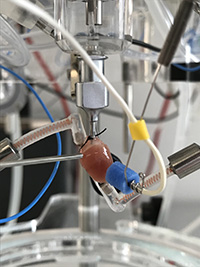Thomsen Group - Cardiac Electrophysiology
Cardiac electrophysiology is the science related to the investigation, diagnosis, treatment, manipulation and challenge of the electrical activities of the heart. This is what we do. Our present aim is to understand how heart failure affects the electrophysiology of the heart and vice versa.

The human heart beats approximately 3,000,000,000 times in a human lifetime. Each beat is a cardiac contraction that pumps blood into the blood vessels of the body. The contraction during each beat and the regular rhythm of the heartbeats throughout life are intricately orchestrated by the heart’s electrical activity. Too many or too few heartbeats will cause immediate symptoms.
We have built a lab to investigate cardiac electrophysiology over a wide range of animals. We use disease models and genetically altered mice to mimic clinical, cardiac and non-cardiac disorders, and study the altered cardiac electrophysiology and arrhythmia vulnerability. We are especially interested in understanding how the hemodynamic changes associated with Heart Failure with preserved Ejection Fraction (HFpEF) changes cardiac electrophysiology and its predisposition to
A broad armamentarium of approaches is key to solving tomorrow’s research questions. In this lab, we take pride in being integrative experimental physiologists, who can draw advantage from many different disciplines, like in-vivo, ex-vivo and cellular electrophysiology, molecular biology, protein chemistry, surgery and pharmacology, to lift and join findings to reach a higher level of understanding.
The laboratories of the Thomsen group is located in the newly renovated animal research floor of the Department of Biomedical Sciences in building 12 and 16, level 5.
Examples of our core techniques are:

Recordings of electrocardiograms (ECG) from anesthetized mice
The surface ECG is central to cardiac electrophysiology. We record high-resolution 6-lead ECGs with minimal noise. Our laboratory is designed to reduce ambient electrical noise, including electrical shielding in the walls. The ECG gives us important information about the global (i.e., whole heart) electrophysiology and can be obtained from any animal, from mice to elephants. And we have done just that.
Intracardiac pacing to induce cardiac arrhythmias
 Using a catheter with a diameter of 0.37 mm, it is possible to pace the heart from within. We pace the heart to control heart rate or to induce arrhythmias. We enter either the right atria and ventricle from the right external jugular vein or the left ventricle from the left common carotid artery. When the catheter is placed correctly, we can record local cardiac activity and pace the heart from the 8 electrodes at the tip of the catheter.
Using a catheter with a diameter of 0.37 mm, it is possible to pace the heart from within. We pace the heart to control heart rate or to induce arrhythmias. We enter either the right atria and ventricle from the right external jugular vein or the left ventricle from the left common carotid artery. When the catheter is placed correctly, we can record local cardiac activity and pace the heart from the 8 electrodes at the tip of the catheter.
Radiotelemetry recordings of ECGs from conscious mice

We surgically place small radiotransitters subcutaneously in mice or rats and after recovery, we can record a 1-lead ECG under conscious conditions. In our telemetry lab, the animals are placed in their home cage on receivers and the signal is recorded continuously. We often record for several days under controlled light/dark cycles.
The Telemetry Unit for Cardiovascular Phenotyping
The Telemetry Unit for Cardiovascular Phenotyping enables low-cost access for all researchers to telemetric recordings of blood pressure and/or ECG from conscious, freely moving mice and rats.
Read more about the Telemetry Unit
Echocardiographic examination of cardiac structure and function
Advanced imaging of the beating heart inside the animal is a key physiological technique to assess both cardiac structure and pumping function. By using non-invasive ultrasound examinations, we can also describe structural and functional remodeling over a period of time using the individual animal as its own control.
Invasive blood pressure recordings
To understand the hemodynamic consequences of cardiac disease, we record blood pressure invasively, either in the carotid artery or in the left ventricle.
Isolated heart studies
 Isolated heart preparations are useful to study the properties of the heart without the influence of the physiological feedback from the remaining organ systems, e.g., the vasculature or the autonomic nervous system.
Isolated heart preparations are useful to study the properties of the heart without the influence of the physiological feedback from the remaining organ systems, e.g., the vasculature or the autonomic nervous system.
We have a state-of-the-art setup for studying isolated mouse hearts using both the Langendorff principle and the working heart principle. We record ECG, coronary flow and pressure, monophasic action potential, afterload and preload, and ventricular pressure in this setup. Via programmed electrical pacing, we can control heart rate. By changing preload, we can study cardiac pump function.
The Thomsen group is looking for motivated students, and we encourage all interested students (bachelor or masters level) to conduct their thesis projects in our lab.
The Thomsen group has a strong profile in in vivo and ex vivo mouse models of heart disease. We investigate electrophysiology and hemodynamics in the mouse heart and perturb homeostasis with e.g. pharmacology. Read more about our current research projects in the “Current Research Projects” section below. Projects can be adapted in case you have a specific interest or desire to learn a specific method.
The Thomsen group offers an international and productive environment. The atmosphere is supportive and motivated. We are located in building 12, floor 5, with other research groups focused on heart, circulation, kidney and lung physiology.
To learn more, please contact Morten B Thomsen.
Please note: Students are not required to hold a FELASA certificate to conduct supervised animal work, but it is useful in starting your own project as well as contributing to other lab members’ projects.
Scientific publishing is not only important; it is also an enjoyable aspect of research. Peer review is central to scientific publishing and it should be done well. I believe that every scientist should review >3 manuscript for every paper he or she publishes.
I am and have been on the editorial board of several scientific journals. I only work with journals owned by a scientific society, because the journals support the society and vice versa. For-profit journals only support the stockholders. For this reason, I am happy to review free for society-owned scientific journals; however, I do require an honorarium (currently USD 450 per manuscript) for reviewing for for-profit journals.
I believe scientific reviewing should be acknowledged, as are publications and attracted funding. I use Web of Science to keep track of my reviewing activities and link to this from my CV. You can see my reviewer profile here.
I arrange PhD-student masterclasses on How to review and What happens once you've submitted your manuscript.
Morten Bækgaard Thomsen has studied cardiac electrophysiology since 2001. Initially, he used a specific cardiac arrhythmia (complete heart block, or atrio-ventricular block) to induce cardiac hypertrophy during his PhD studies in the Netherlands. These hypertrophic hearts were more prone to another arrhythmia: torsades de pointes, and he studied how to predict onset of this arrhythmia. If you can predict it, you can prevent it. Prevention is better than treatment. In the case of torsades de pointes arrhythmias treatment could include defibrillation, i.e., administering a large electrical shock to the chest.
Later, at Columbia University in New York City, Morten studied how cardiac electrophysiology was altered by the presence of a single, small protein, called KChIP2. He found that this protein altered the calcium current in the heart cells and showed how a single protein can affect several different ion channels.
In 2009, Morten started at the University of Copenhagen as group leader within the Danish National Research Foundation Centre for Cardiac Arrhythmia. The centre expired in 2015 and he entered as faculty in the Department of Biomedical Sciences. Today, he studies how lifestyle and disease affect cardiac electrophysiology.
Over the years, the lab has received funding from (in alphabetical order):
Aase og Ejnar Danielsen Foundation
Arvid Nilsson Foundation
C.C. Klestrup og Hustru Henriette Klestrup Foundation
Danish Agency for Science, Technology and Innovation, Medical Research Council
Foundation Juchum
Snedkermester Sophus Jacobsen og Hustru Astrid Jacobsen Foundation
Vissing Foundation
Group Leader
Morten B. Thomsen
Associate Professor
Phone +45 2383 9884
mbthom@sund.ku.dk
ORCID: 0000-0002-2469-6458
Group members
| Name | Title | Phone | |
|---|---|---|---|
| Thomsen, Morten Bækgaard | Associate Professor | ||
| Usai, Diana Sofia | PhD Fellow | +4535329413 | |
| Zawadzki, Tamzin Sarah | Postdoc | +4535323304 |

